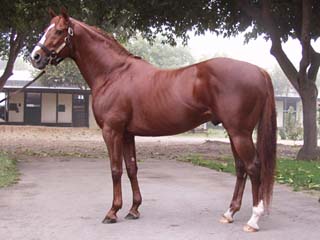First I'll outline the basics:
- Use an uncluttered background that contrasts with your horse's colour.
- You can use either a halter or a bridle, but a bridle looks best. Make sure that the bridle is clean and well-fitting. If you must use a halter, use one made of leather if possible.
- Stand your horse so that all four legs are visible. Ideally, the legs nearest to the photographer will be square under the horse and the legs on the far side will be placed more under the horse's belly.
- Groom your horse well before taking the photo!
- Try to have the horse take up most of the frame. The handler does not need to be in the photo.
- Try to have the horse's head turned slightly towards the camera so that any markings are visible. Try not to have the head turned too much or your horse will look like it has no neck!
Now I will go through a few examples of potential passport photos in order to show you exactly why it's best to follow those outlines.
Example 1
While this horse is groomed beautifully and is standing against a nice background, this photo would not be suitable for a passport. This is because not all four legs are clearly visible. The right front leg is hidden completely and most of the right rear leg is hidden as well. This is, however, a very nice example of how much your horse's head should be turned towards the camera; the stripe on his face is visible but the head is not turned so much that it makes his body look out of proportion.
Example 2
This is a very nice photo that would likely be accepted for a passport. This horse is beautifully turned out and he is presented against a nice background. All four legs are clearly visible and he is taking up the entire frame. His shiny and well-fitting leather halter does not detract from the photo. The only downside to this photo is that the horse's head is not turned towards the camera. If his head was turned slightly towards the photographer so that his markings, or lack thereof, were visible, this photo would be perfect.
Example 3
This is again a photo that would probably be accepted for a passport. This horse is well-groomed and all four legs, as well as his facial markings, are clearly visible. The photo would be even better if the photo was not taken on a slight angle. Because the horse's back end is closer to the camera than the front end, his body looks slightly disproportional. This is, however, only an aesthetic issue. The halter name plate is also slightly distracting but it is within the rules.
Example 4
This photo is not acceptable as a passport photo. Only two legs are clearly visible as the right front is hidden by the left front, and the right hind is hidden behind the tail. That is what would cause the photo to be refused, but there are aesthetic issues with this one as well. The horse's head is turned slightly towards the camera, which is good, but the over-sized blue nylon halter is distracting. The handler and the white lead rope are also visible and distracting.










